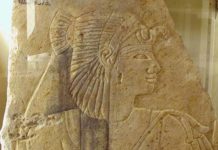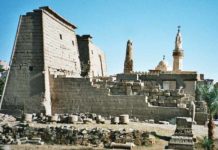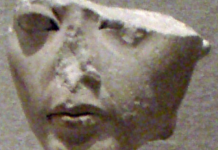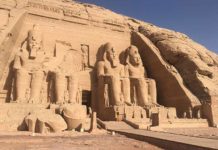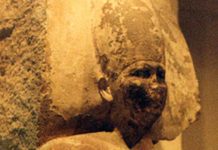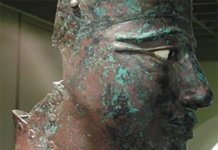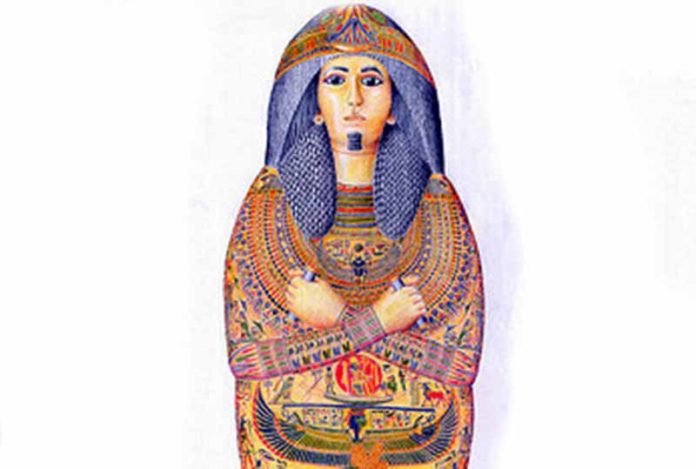
Nesyamun (previously known as Natsef-Amun) is an Egyptian mummy from around 1100 BC, currently held in Leeds City Museum. He arrived in the museum in 1823, and since then the mummy and its sarcophagus have been the subject of extensive research.
Who Was Nesyamun?
From a study of the decorations and inscriptions on the mummy sarcophagus, researchers have been able to learn a lot about the life of Nesyamun. He was a priest of the god Amun-Re at the Temple of Amun at Karnak, Thebes (modern day Luxor). Here prayers, rituals and offerings were given by the priests on behalf of the king; ancient Egyptian temples such as those at Karnak were not designed for congregational worship as modern holy buildings often are.
The inscriptions on the coffin tell us that Nesyamun was an incense bearer and scribe. His titles included ‘Scribe of the Accounts of the Cattle of the Estate of Amun’, ‘Scribe to the Shrine of Montu, the Lord of Thebes’, and ‘Scribe of the Oblations made to all the Gods of Upper and Lower Egypt.’ His duties would have included completing inventories, reports, documents and other admin, and his chief responsibility was to record the quantity of corn eaten by the Sacred Cattle. These were the animals that would be killed and offered at a daily banquet in honour of the gods.
Nesyamun was a ‘waab-priest’, meaning that he had attained a level of physical and spiritual purity needed to enter the gods’ presence. As a waab-priest he would only wear clothes of linen and shoes of papyrus (wool, leather and other animal products being forbidden). He would shave his head and body daily, bathe twice a day and twice a night, and would have been circumcised on entering the priesthood. Certain foods would also have been forbidden to him.
The Life of an Ancient Egyptian Priest at Karnak
Life at the temple complex at Karnak would have involved three daily sacrifices to the god, including offerings of clothes, incense, food and other trinkets. A fair amount of time might have been spent by the scribes in the ‘House of Life’, a building attached to many major temples, where religious texts were written and copied. A priest such as Nesyamun might also visit the Temple of Montu, god of war, situated within the complex near to the Temple of Amun.
The priests were organised into four groups that served on a rotational basis. Each group would serve at the temple complex for a month at a time, three times a year. In the intervening periods, they were permitted to pursue family life, get married and have children, living outside the temple complex. Nesyamun’s own wife was the daughter of one of Karnak’s most important officials. According to a tradition of passing down the priesthood in certain families, his son succeeded him as priest when he died.
Nesyamun’s Death and the Mummy Sarcophagus
Examinations of Nesyamun’s mummy have not led to any certain answers as to what killed him. The mummy’s open mouth and protruding tongue is unusual, suggesting that he was perhaps stung by an insect, or suffered some other kind of allergic reaction. Speculations that he may have been strangled have been dismissed as no damage to the neck has been found.
According to custom, his body was mummified and placed inside a sarcophagus. The decorations on the coffin include images of Nesyamun as a priest (upper lid) and of the gods he served (bottom lid). It also displays hieroglyphics telling us about his life, as well as spells and blessings from the Egyptian ‘Book of the Dead’, perhaps meant as protection for his journey to the afterlife.
The face on the coffin is not Nesyamun’s own, but a standard image of an Egyptian man. This is why the representation has hair when Nesyamun himself was bald. There is a small hole in the chin where a beard would have been attached, but this has been damaged. The mummy sarcophagus and Nesyamun himself can be seen in a reconstructed Egyptian tomb at Leeds City Museum.


